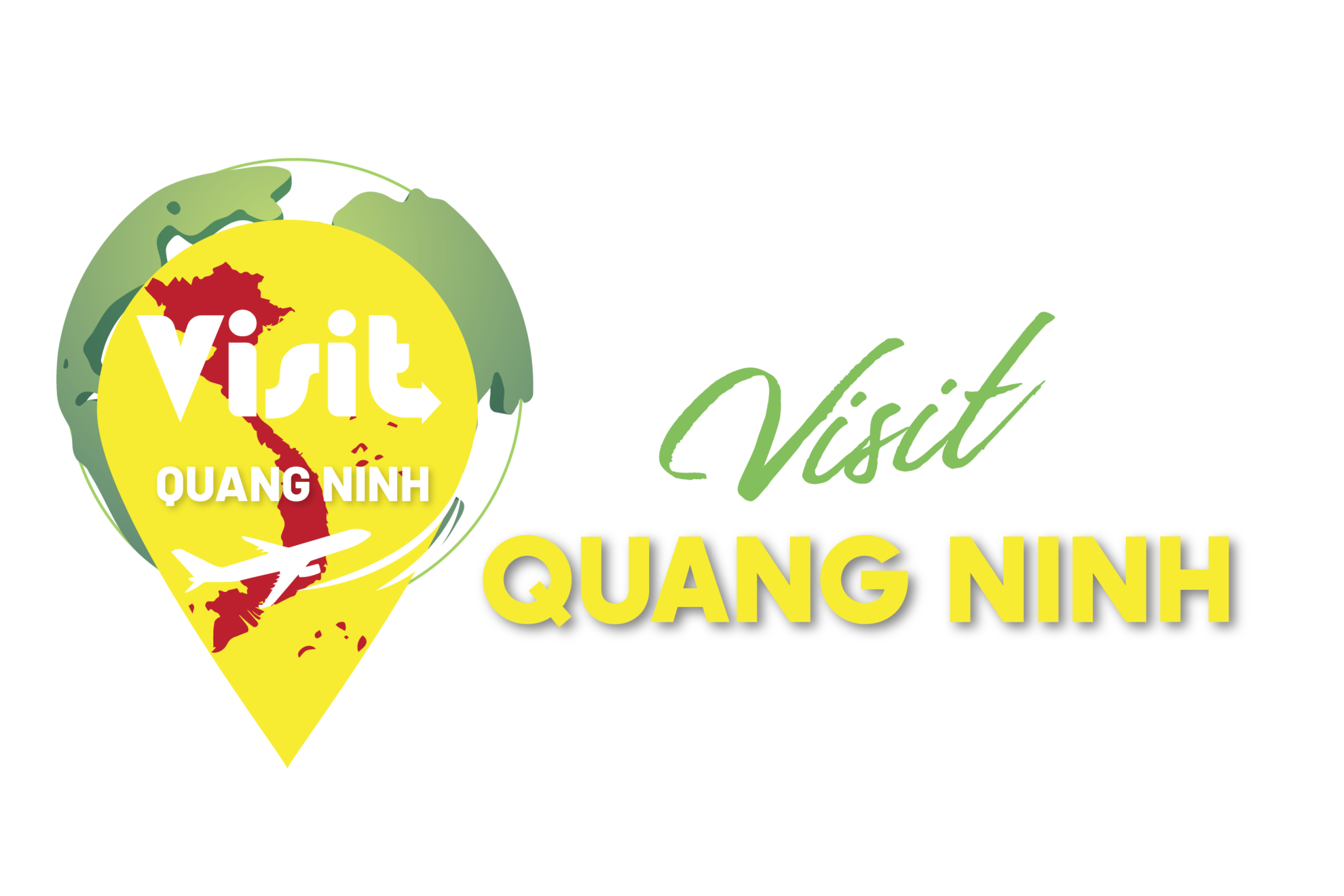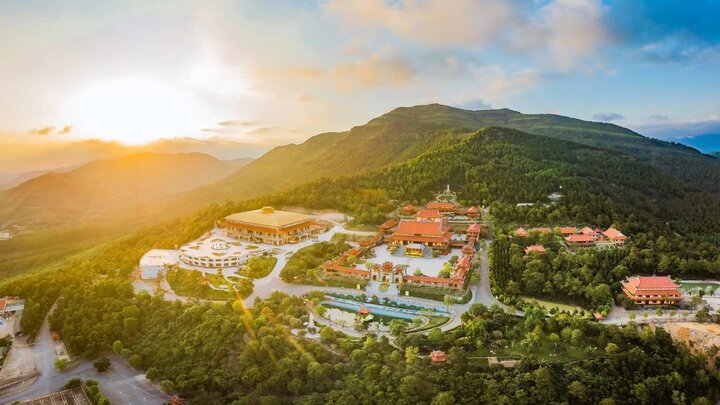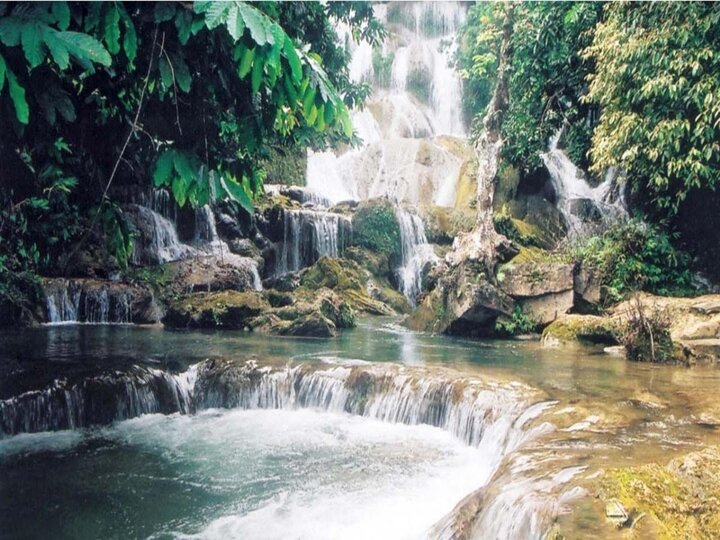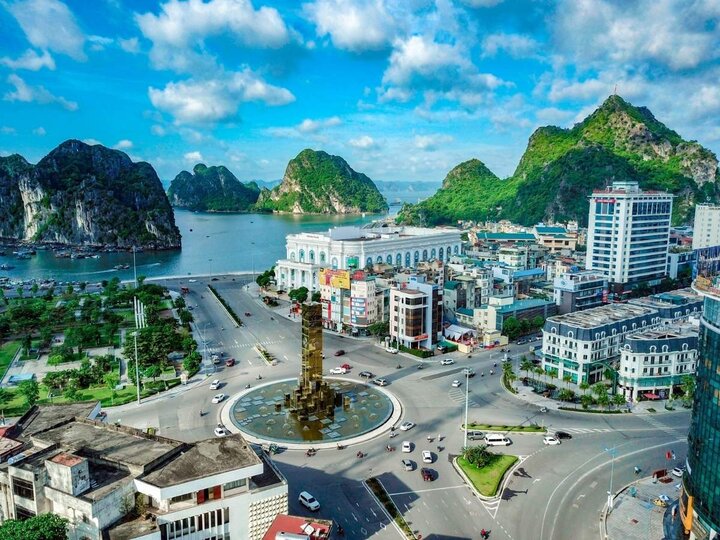1. Overview of Ba Vang Pagoda Quang Ninh
1.1. Geographical location and terrain of Ba Vang Pagoda Quang Ninh
Located on the slope of Thanh Dang mountain in Uong Bi ward, Ba Vang Pagoda Quang Ninh. The pagoda is built at an altitude of 340 m above sea level. The pagoda's location is on the 'tọa sơn hướng thủy' (sitting on a mountain, facing water) terrain, facing west, towards the center of Uong Bi city, with the gentle Bach Dang river flowing in front.
From the pagoda area, visitors can admire the distant scenery of Do Son port and sea. To the left are the continuous Thanh Long mountains, to the right is the sturdy Bach Ho range, and behind the pagoda is a deep green ancient pine forest, creating an almost perfect natural landscape. The entire space is surrounded by a rich ecosystem, creating a tranquil and serene atmosphere for worship and study activities here.
1.2. Why Ba Vang Pagoda is a prominent spiritual destination?
What makes Ba Vang Pagoda so attractive is its position as a major Buddhist center in the North. It belongs to the Truc Lam Yen Tu Zen school, a Vietnamese Zen lineage closely associated with national beliefs. The pagoda stands out due to its magnificent architecture, including the Dai Hung Bao Dien (Great Buddha Hall), the largest in Indochina, and exquisite sculptures made from precious wood and natural stone, harmoniously blending tradition with modern elements.
The cultural and historical significance of the pagoda is closely tied to the development of Vietnamese Buddhism. Especially the Truc Lam Yen Tu Zen school from the 13th century, making the pagoda a typical center for cultural and spiritual activities. This place regularly hosts important festivals and large retreats that attract Buddhists from all over, contributing to the preservation and promotion of the precious spiritual heritage of the Northeast region.
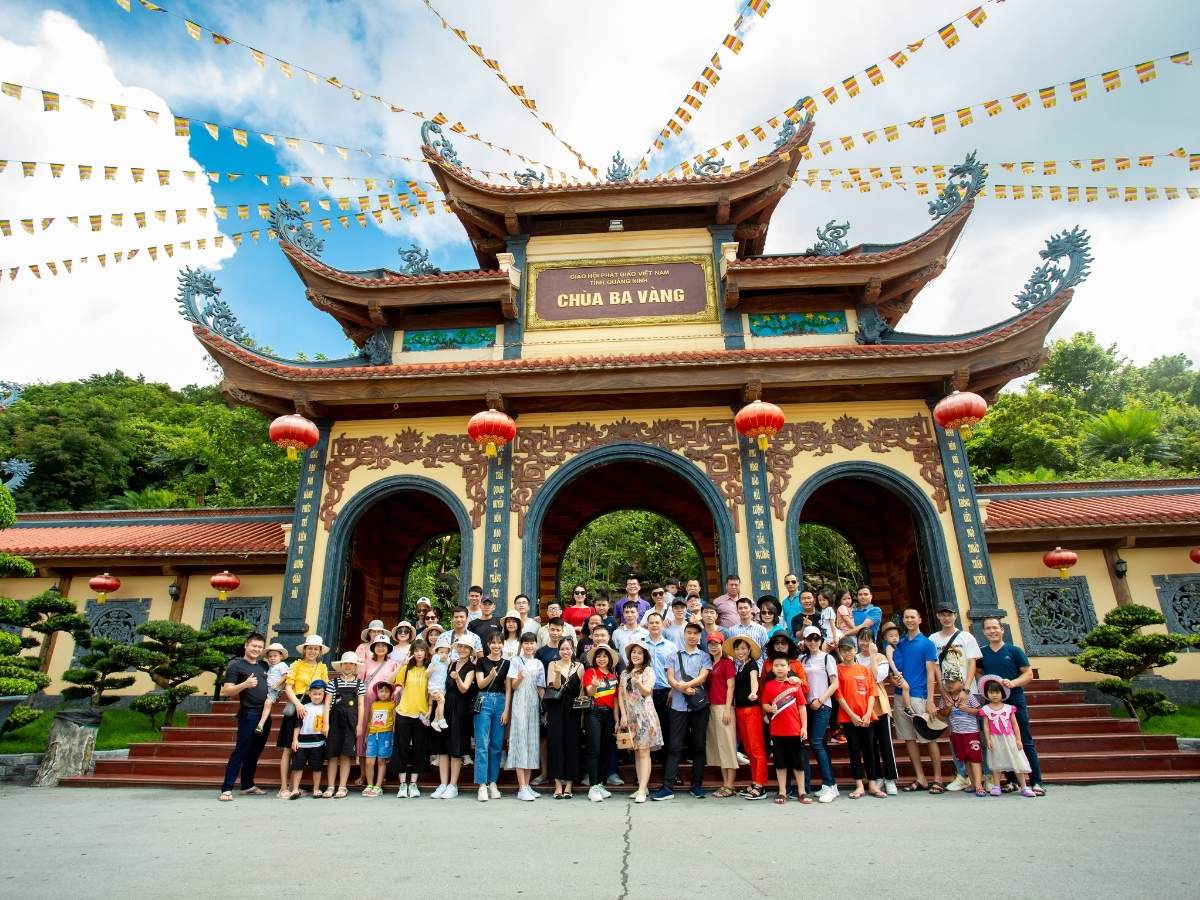
What makes Ba Vang Pagoda so attractive is its position as a major Buddhist center of the Northern region. (Source: Collected)
2. How to get to Ba Vang Pagoda, Quang Ninh
2.1. Traveling from Hanoi and Northern provinces
Visitors departing from Hanoi or the Northern provinces can reach Ba Vang Pagoda by coach or private car via National Highway 18, with travel time ranging from about 2-3 hours depending on traffic conditions. This route is regularly maintained, ensuring safety and convenience. Coach services run continuously throughout the day, allowing visitors flexibility in scheduling.
Travel costs are reasonable, with coach ticket prices ranging from 150,000 to 300,000 VND/trip; if using a private car, fuel costs and other expenses are around 300,000 to 500,000 VND depending on the vehicle type. This option is very suitable for those who want to independently stop for rest and explore attractions along the way.
2.2. Traveling from Ho Chi Minh City and the Southern region to Quang Ninh.
For visitors from Ho Chi Minh City and the Southern provinces, flying to Van Don Airport. Or Noi Bai Airport and then continuing to travel by coach, taxi, or private hired car to Uong Bi to visit Ba Vang Pagoda is the most convenient option. Van Don Airport is closer, taking only about 1 hour to travel further.
Another option is to take the North-South train to Hanoi Station, then take a coach or bus to Uong Bi, with a total travel time of about 1 day. Although it takes longer, this method offers the experience of sightseeing along the way and fully enjoying the journey. Train ticket prices range from 800,000 to 1,500,000 VND depending on the seat type.
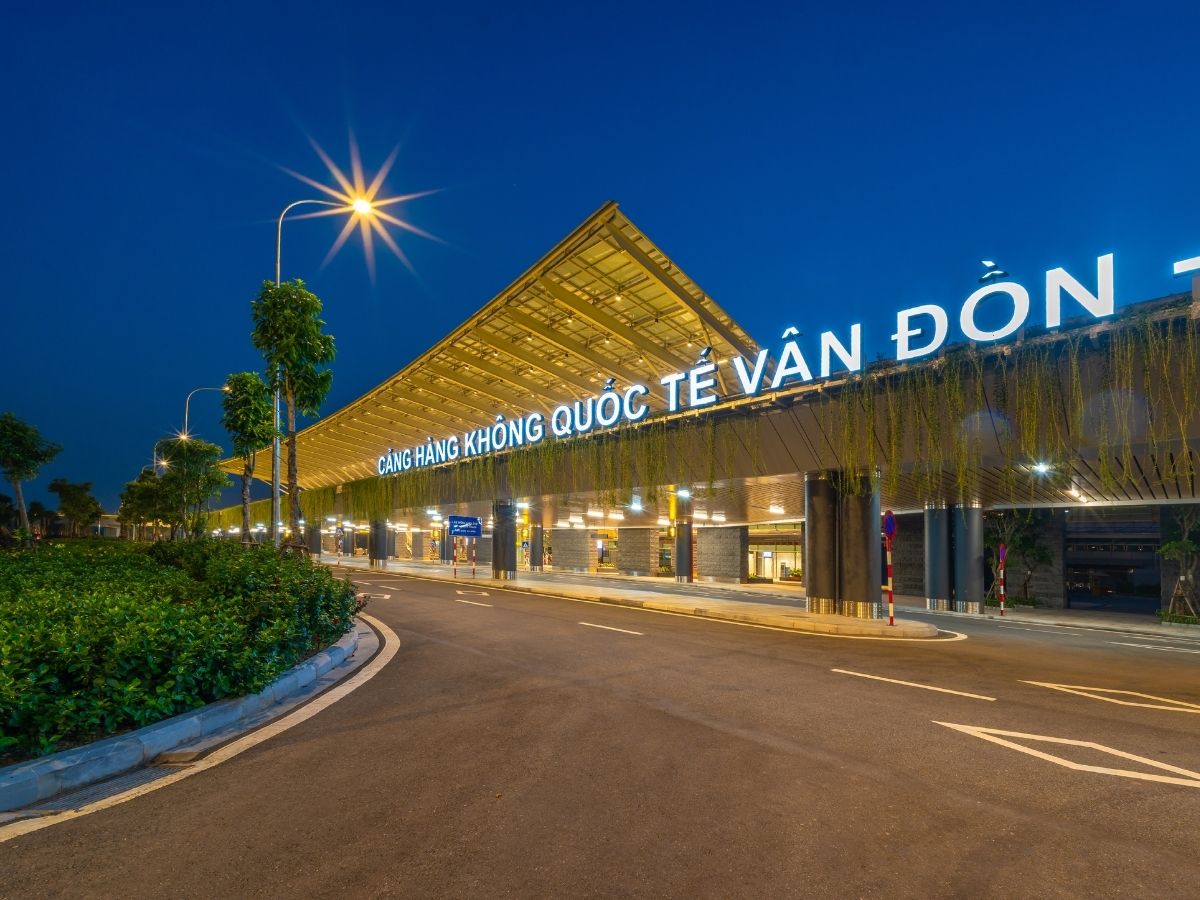
For visitors from Ho Chi Minh City and southern regions, fly to Van Don Airport. (Source: Collected)
2.3. How to travel within Uong Bi to Ba Vang Pagoda.
Once in Uong Bi, visitors have many transportation options to reach Ba Vang Pagoda such as taxi, local bus, electric car, or shuttle services to the foot of the pagoda. Taxi is a convenient option with a fare of about 50,000 to 80,000 VND from the city center. Local buses are more cost-effective, however, it's necessary to know the schedule to avoid missing the bus.
The area of Ba Vang Pagoda has a spacious, scientifically arranged parking lot, along with a check-in spot right at the foot of the mountain, next to the Tam Quan gate, convenient for visitors using cars or motorbikes. From the parking lot, just a short walk across beautifully designed stone steps leads to the pagoda grounds.
3. History of formation and development of Ba Vang Pagoda, Quang Ninh
3.1. Origin, legends, and historical marks
Ba Vang Pagoda, Quang Ninh was founded in 1706, during the reign of King Le Du Tong. Through many historical events and the devastation of war, the pagoda was severely damaged.
In 1988, the pagoda was restored and renovated almost entirely with wooden materials. Later, in 1993, Quang Ninh province continued to plan and rebuild the entire pagoda complex. Currently, the remaining ancient traces consist only of an incense stone pillar, a stele for the spirit of the monk, and column base stones, as evidence of the long history of this ancient pagoda.
In January 2011, due to the need for spiritual activities and the propagation of Buddhist teachings for monks, nuns, and Buddhists, Ba Vang Pagoda was rebuilt on a large scale with magnificent architecture, harmonizing tradition and modernity. Thanks to systematic investment and a serene atmosphere, the pagoda today has become one of the most prominent spiritual tourist destinations in Quang Ninh, attracting a large number of visitors and pilgrims from all directions to visit and worship Buddha every year.
3.2. Ups and downs, restoration, and major renovation in modern times.
The period of brilliant development of Ba Vang Pagoda is recorded in 1706 during the reign of King Le Du Tong. Thanks to the contributions of eminent monks of the Truc Lam Zen sect, such as Patriarch Tue Bich Pho Giac, the pagoda was significantly expanded. However, through historical upheavals and natural impacts, the pagoda was once destroyed, leaving only a few valuable relics.
From 1987 to 1993, Ba Vang Pagoda began to be restored, mainly using wooden materials. Especially from 2007, under the guidance of Venerable Thich Truc Thai Minh, along with the support of the local government, a major renovation project was carried out. Many solid and modern structures were built, but still retaining characteristic traditional architectural features.
3.3. Major inauguration events and development role in recent years
In 2011, Ba Vang Pagoda, Quang Ninh began a large-scale major renovation, combining modern elements and preserving traditional values. On March 9, 2014, the Dai Hung Bao Dien (Great Buddha Hall) and many key items were inaugurated in a solemn atmosphere. Following on September 16, 2014, the inauguration ceremony of the Three Patriarchs' Temple and the great statue of Amitabha was solemnly held.
Today, Ba Vang Pagoda has become the largest Buddhist center in Quang Ninh province. It currently attracts millions of visitors annually, recognized as a unique spiritual destination nationwide. The pagoda is continuously invested in and perfected, becoming a typical spiritual and cultural symbol of the Quang Ninh region.
4. Impressive architecture and space of Ba Vang Pagoda, Quang Ninh
4.1. Overall architecture: combining tradition and modernity
Ba Vang Pagoda possesses the characteristic traditional architecture of Northern Vietnamese pagodas with gracefully curved roofs and intricate carvings of the four sacred creatures (Dragon, Unicorn, Tortoise, Phoenix). The pagoda uses primarily precious wood and natural stone, all gilded with gold leaf and lacquered, creating a solemn atmosphere. The pagoda's layout includes a 3-bay worship hall, a 1-bay inner sanctuary, and a 2-story, 8-roof main hall, with scientifically connected areas convenient for movement and worship.
Notably, Ba Vang Pagoda has achieved a sophisticated blend of tradition and modernity. Besides the ancient structures, the pagoda also added guesthouses, refectories, libraries, and new bell towers with modern architectural styles, yet harmonizing with the traditional overall. This combination creates a space that both honors history and meets modern religious needs.

Ba Vang Pagoda possesses traditional architectural features characteristic of Bac Bo pagodas. (Source: Collected)
4.2. Outstanding features within the pagoda grounds
The Dai Hung Bao Dien of Ba Vang Pagoda Quang Ninh is the most prominent structure with a two-tiered roof design, capable of accommodating thousands of people, serving as the venue for the pagoda's most important ceremonies. The imposing Tam Quan serves as the main entrance, with a crescent-shaped lake in front, reminiscent of the One Pillar Pagoda, creating an impressive focal point for the pagoda's facade.
The large wooden statue of Amitabha Buddha is placed in the center, serving as a special symbol of the pagoda. The large single-log drum, made from a solid piece of red wood, is considered the largest drum in Vietnam, emitting a far-reaching sound during each ceremony. The bell tower houses a bronze bell used to signal during festivals and retreats. The garden space, lotus pond, and ancient well create a fresh, tranquil environment, contributing to the overall serenity of the grounds.

The crescent lake evokes the image of the One Pillar Pagoda, creating an impressive highlight for the temple's facade. (Source: Collected)
3.3. Surrounding Space: Landscape, Pine Forest, and Temple Branches
The landscape outside Ba Vang Temple is a blend of nature with ancient pine forests and lush vegetation, creating an ideal environment for meditation and finding peace. The sounds of the wind, birdsong, and fresh air bring a sense of lightness and tranquility to visitors.
The system of satellite temples such as Thien Lai, Dien Phuc, and De Thich contributes to forming a strong Buddhist network, expanding positive influence throughout the region. These temples not only meet religious activity needs but also support the preservation and development of local spiritual culture, creating a diverse and rich Buddhist ecosystem.
5. Spiritual, Cultural, and Festival Experiences at Ba Vang Temple, Quang Ninh
5.1. Buddhist Activities, Meditation Retreats, and Experiences for Buddhists and Visitors
Ba Vang Temple regularly organizes summer meditation retreats for youth, as well as intensive study programs for Buddhists from all over the country, with the aim of building a virtuous community and living a good life while practicing virtue. These programs are not only educational but also help young people better understand traditional values and train their spirits. Major festivals such as Buddha's Birthday, Ullambana, ceremonies for national peace and prosperity, and ceremonies for the souls of the departed are organized on a large scale, attracting a large number of Buddhists and creating meaningful community cohesion.
Ba Vang Temple is expected to expand its scale of service for Buddhists and visitors through various experiential activities and innovations in religious practices and moral education. These programs offer many opportunities for learning and self-development, while also contributing to raising awareness of the traditional spiritual cultural values of Vietnamese people.

Ba Vang Pagoda regularly organizes summer meditation retreats for teenagers. (Source: Collected)
5.2. Traditional Festivals and Unique Spiritual Events
The Lantern Festival is the most prominent event of the year at Ba Vang Pagoda, usually held on major holidays. The image of thousands of shimmering lanterns on the water, combined with the sincere prayers of Buddhists, has created a sacred and moving atmosphere.
Additionally, there are early spring festivals, the Thuong Nguyen Festival, and Yen Tu region traditional festivals held throughout the year, attracting the interest of many tourists, contributing to spreading unique cultural beauty.
These festivals and events not only have spiritual significance but also provide an opportunity for tourists to learn more deeply about the customs and traditions of the local people. Each festival has its own unique characteristic, creating diversity in the religious cultural life at Ba Vang Pagoda.
5.3. Ba Vang Pagoda in Quang Ninh as a Regional Cultural Center
Ba Vang Pagoda is a convergence point for spiritual activities, contributing to preserving and promoting the Truc Lam Yen Tu heritage, a Zen lineage deeply imprinted with national identity. The pagoda has become a spiritual and cultural center, a place to convey moral values and a virtuous lifestyle to the community. The pagoda's influence is not limited to the religious sphere but also extends to many aspects of society.
Besides, Ba Vang Pagoda is also a major driving force for the development of spiritual tourism, aiming for a 'green tourism' model. Helping to build the image of Quang Ninh as a prominent cultural and spiritual destination in the North. This creates sustainable economic value, while affirming the position of Quang Ninh province on the national tourism map.
6. Experience visiting Ba Vang Pagoda in Quang Ninh
6.1. Ideal time to visit, attire, customs to note
The best time to visit Ba Vang Pagoda is the festival season from the 1st to the 3rd lunar month. Or during the Buddha's Birthday and Vu Lan festivals, when the weather is pleasant and many unique cultural and spiritual activities take place. During these months, the weather is cool, the natural scenery around the pagoda is also beautiful, with lush greenery.
Regarding attire, visitors should choose polite and modest clothing, prioritizing light, comfortable materials for easy movement.
When entering the main hall, one should avoid wearing overly short or tight clothing to show respect at the sacred Buddhist site.
The color palette for clothing should be soft tones such as white, gray, beige, or pastel.
Adhering to dress code regulations is not just a matter of politeness but also helps each person integrate into the solemn and respectful atmosphere of the pagoda.

Visitors should choose polite, discreet clothing, prioritizing light, comfortable materials for easy movement. (Source: Collected)
6.2. Photo suggestions, notable check-in spots within the pagoda grounds
Ba Vang Pagoda boasts many beautiful and prominent photo spots, such as the crescent lake simulating the One Pillar Pagoda, where the water surface reflects, creating a unique visual effect. The Tam Quan Gate, the tall bell tower, the green pine forest, and the blooming lotus pond are all ideal highlights for photos imbued with the architectural style of Northern Vietnamese pagodas.
The ideal time for photography is early morning from 6 to 8 AM, or in the afternoon from 4 to 6 PM when the soft light creates beautiful effects. It is advisable to choose neutral-colored attire, traditional ao dai, or modest outfits to suit the pagoda's atmosphere. When taking photos, pay attention to maintaining order, not disturbing religious activities or the solemnity of the pagoda.
6.3. Small tips for worship, sightseeing, environmental preservation, and civilized behavior
For large groups, booking a tour guide in advance will make the visit more meaningful and easier to access information about the pagoda's history and culture.
Visitors should pay attention to preparing their health, as there will be a lot of movement, walking up and down stone steps; those with health issues should reconsider or prepare adequately.
Actively maintain general hygiene, do not litter, do not pick flowers or break branches, and always protect the surrounding landscape and natural environment.
Behave civilized by not gathering noisily, maintaining general order, and respecting the sacred space and those who are performing rituals.
These actions demonstrate self-awareness and contribute to preserving the beauty and spiritual values of the pagoda for future generations.
7. Tourist attractions and culinary experiences to combine when visiting Ba Vang Pagoda, Quang Ninh
7.1. Suggestions for combining visits to Yen Tu, Sun World Ha Long, and Yen Trung Lake.
A trip to Ba Vang Pagoda, Quang Ninh will be more complete if combined with visits to nearby famous attractions. With a 1-day itinerary, you can visit the pagoda in the morning and head to Yen Trung Lake in the afternoon, known for its clear blue water and majestic mountain scenery.
If you have 2 days, explore the Sun World Ha Long tourist area, about 40 km away, and experience activities on Ha Long Bay. Yen Tu is a place where natural beauty and spirituality converge, while Sun World Ha Long offers modern entertainment activities suitable for all ages.
7.2. Outstanding cuisine, vegetarian restaurants, and specialties of the Uong Bi region.
The area around Ba Vang Pagoda has many restaurants and vegetarian eateries serving a rich menu for visitors. Vegetarian dishes such as banana blossom salad, vegetarian spring rolls, braised tofu, mushroom soup, and lotus seed sweet soup are all delicately and nutritiously prepared.
Additionally, you can enjoy specialties from the Uong Bi region such as Yen Tu plum wine, crispy banh tai long diep, and dishes made from cassava and potato. These dishes are not only delicious but also carry the distinct flavor of the Quang Ninh countryside, making the culinary experience more complete. Prices range from 30,000 to 100,000 VND per serving depending on the dish and location.
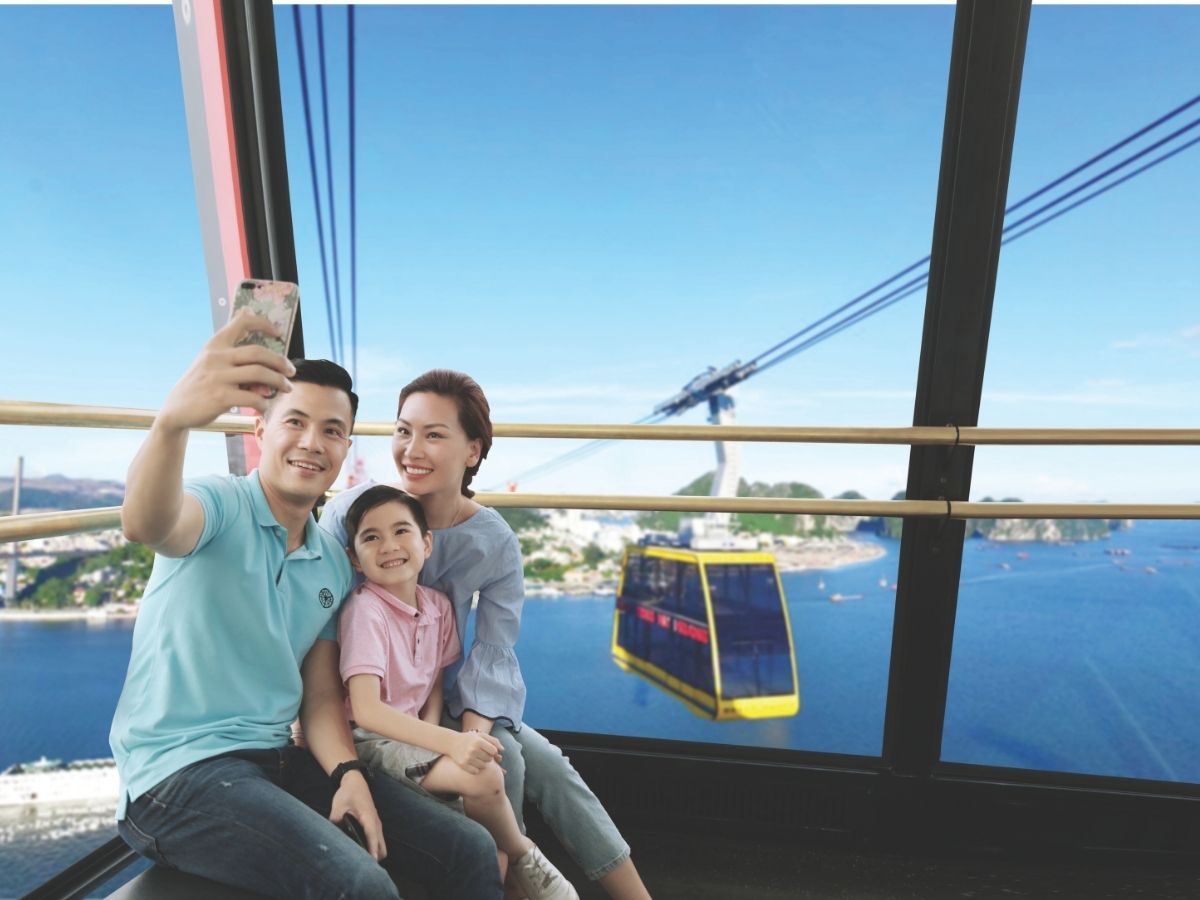
Discover Sun World Ha Long resort about 40 km away and experience activities on Ha Long Bay.
Ba Vang Pagoda Quang Ninh is the convergence point of the most outstanding architectural, cultural, historical, and spiritual quintessence of the Northeast region, worthy of being an unmissable destination for all tourists and Buddhists. Coming to Ba Vang, you not only worship at a sacred and ancient place but also have the opportunity to immerse yourself in festivals, experience modern Vietnamese Buddhism in a peaceful and fresh environment, contributing to preserving national cultural values. Arrange your time to visit this sacred pagoda to fully feel the spiritual beauty in the heart of Uong Bi city!
